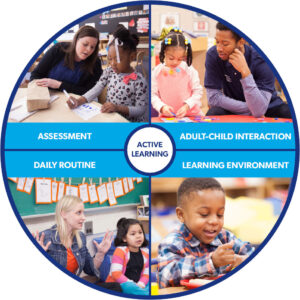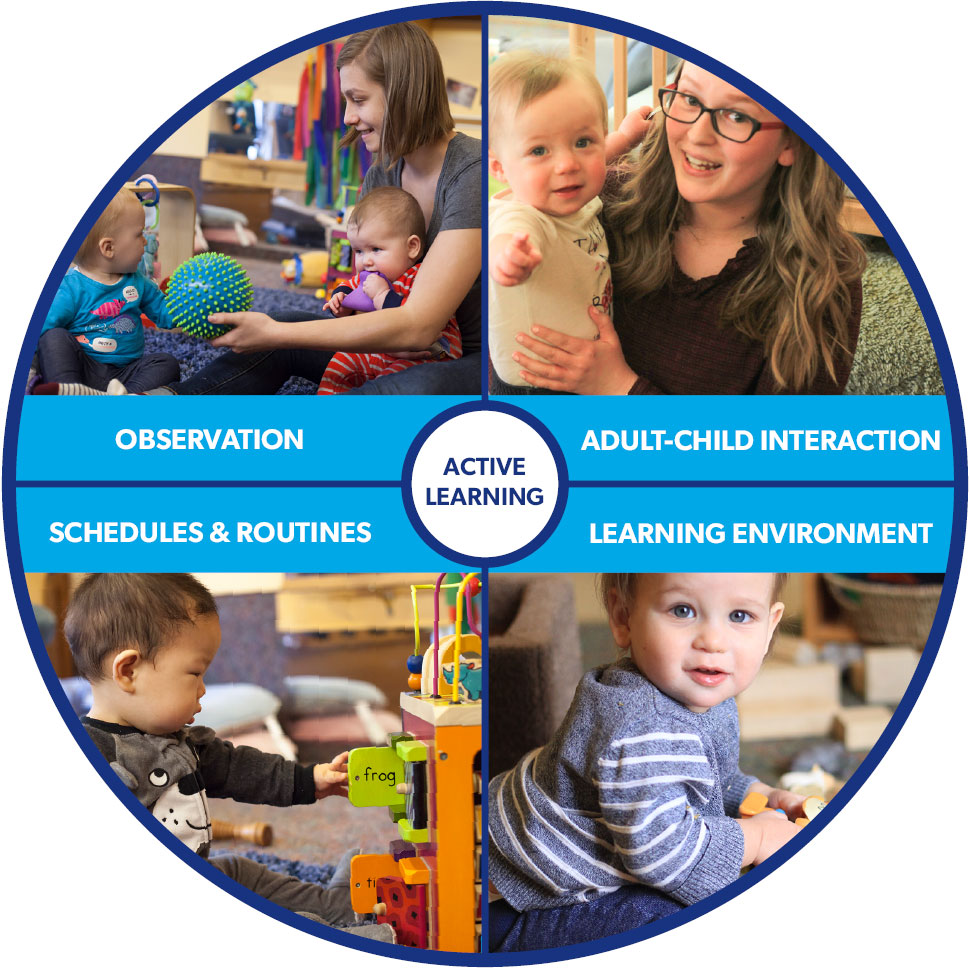

How We Teach Preschool (ages 3-6)
In a HighScope preschool program, teachers ignite children’s interest in learning by creating an environment that encourages them to explore learning materials and interact with adults and peers. We focus on supporting early learners as they make decisions, build academic skills, develop socially and emotionally, and become part of a classroom community.
Active learning is at the center of the HighScope Curriculum. It’s the foundation of young children gaining knowledge through their natural play and interactions with the environment, events, and other people.
Adult-Child Interaction
Teachers act as partners, working alongside children and communicating with them both verbally and nonverbally to encourage learning. Key strategies for adult-child interactions are sharing control with children, communicating as a partner with children, scaffolding children’s play, using encouragement instead of praise, and taking a problem-solving approach to supporting children in resolving conflicts.
Learning Environment
To create a predictable and active learning environment, teachers arrange and equip the classroom with diverse, open-ended materials that reflect children’s home, culture, and language. The room is organized and labeled to promote independence and encourage children to carry out their intentions.
Daily Routine
A consistent framework for the day provides a balanced variety of experiences and learning opportunities. Children engage in both individual and social play, participate in small- and large-group activities, assist with cleanup, socialize during meals, develop self-care skills, and exercise their small and large muscles. The most important segment of the daily routine is the plan-do-review sequence, in which children make decisions about what they will do, carry out their ideas, and reflect upon their activities with adults and other children. These higher-level thinking skills are linked to the development of executive functions, which are needed to be successful in school and life.
Assessment
Ongoing child assessment is also an underlying component of the HighScope Curriculum. Objective anecdotal observations of children collected throughout children’s natural play allow teachers to assess child progress and plan meaningful learning experiences.
What We Teach
The HighScope Preschool Curriculum is based on more than 50 years of research on early childhood development and has been validated by direct evaluation of the curriculum. Our framework for understanding and supporting children’s learning from ages 3–6 years is based on 58 key developmental indicators (KDIs), which are aligned with national and state early learning standards, Common Core State Standards, and the Head Start Early Learning Outcomes Framework.
In the HighScope Preschool Curriculum, learning is focused on the following eight content areas:
- Approaches to Learning
- Social and Emotional Development
- Physical Development and Health
- Language, Literacy, and Communication
- Mathematics
- Creative Arts
- Science and Technology
- Social Studies
Preschool Curriculum Content
Learning in these eight areas is guided by 58 key developmental indicators (KDIs). Each KDI identifies an important learning goal for young children. We recognize that the normal pace of children’s development and learning varies widely across these eight categories and the KDIs reflect that continuum of widely held expectations. Our curriculum is designed to help teachers appropriately scaffold learning for every child across all areas.
The HighScope key developmental indicators
- Provide teachers with a child development “filter” for observing and choosing appropriate interactions and activities
- Help teachers interpret what young children say and do along a developmental continuum
- Enable teachers to maintain reasonable expectations for young children
- Reinforce children’s play as the primary mechanism for learning
- Allow teachers to be more knowledgeable and intentional in their daily planning for individual children and the class

How We Teach Toddlers
Your youngest learners need to feel safe and supported so they can learn with their whole body and all of their senses. In a HighScope toddler program, teachers focus on developing supportive, trusting relationships with the children in their care. We create rich environments that encourage very young children to explore and discover the world around them, helping them to engage in experiences designed to support their optimal development in all domains.
At HighScope we value and respect parents as their children’s first teachers. That’s why we encourage teachers to partner with parents in learning everything they can about their toddlers to better care for their needs and plan for their development. As a result, our programs create a strong three-way bond between child, parent, and caregiver.
Active learning is at the center of the HighScope Curriculum. It’s the foundation where young children gain knowledge through their natural play and interactions with the environment, events, and other people.
Adult-Child Interaction
Nurturing, responsive teachers practice primary caregiving and continuity of care by scaffolding the individual needs and temperaments of toddlers. Key strategies for adult-child interactions are touching, holding, playing alongside toddlers at their level and pace, communicating in give-and-take exchanges verbally and nonverbally, respecting children’s choices and encouraging their efforts, acknowledging children’s strong emotions, and involving toddlers in resolving conflicts.
Learning Environment
The physical space is safe, flexible, and child oriented to provide comfort and accommodate the changing developmental needs and interests of the earliest learners. The space is organized into play and care areas that serve the needs of toddlers and stocked with a variety of sensory-motor materials that toddlers can reach, explore, and play with in their own way at their own pace. With nurturing and responsive caregivers as a home base, toddlers are free to move about, explore materials, exercise creativity, and solve problems.
Schedules and Routines
A consistent yet flexible routine that accommodates individual children’s natural rhythms and temperaments gives toddlers a sense of security and stability that creates trust between the child and teacher and builds independence as children engage with their environment and the people around them. Each routine is built around daily events and caregiving routines that value toddlers’ active learning.
Observation
Ongoing child and program assessment is an underlying component of the HighScope Curriculum. Objective observations of children allow teachers to intentionally plan to build on individual and group interests and scaffold development by supporting what children know while gently extending their learning.
What We Teach
Grounded in current child development theory and research, the HighScope Infant-Toddler Curriculum is evidence-based. Our framework for understanding and supporting toddlers’ learning from birth to age three is based on 42 key developmental indicators (KDIs) which align with national and state early learning guidelines and the Head Start Early Learning Outcomes Framework.
In the HighScope Infant-Toddler Curriculum, learning is focused on these six content areas:
- Approaches to Learning
- Social and Emotional Development
- Physical Development and Health
- Communication, Language, and Literacy
- Cognitive Development
- Creative Arts
Toddler Curriculum Content
Early learning and development in these six content areas is guided by 42 key developmental indicators (KDIs) — the skills and behaviors at each stage of development that pave the way for school and adult success. Each KDI is connected to and reinforced by scaffolding strategies to help teachers appropriately support and gently extend children’s learning.
The HighScope key developmental indicators
- Provide teachers with a child development “filter” for observing and choosing appropriate interactions and activities
- Help teachers interpret what young children say and do along a developmental continuum
- Enable teachers to maintain reasonable expectations for young children
- Reinforce children’s play as the primary mechanism for learning
- Allow teachers to be more knowledgeable and intentional in their daily planning for individual children and the class